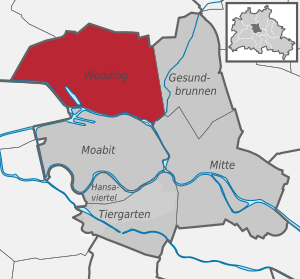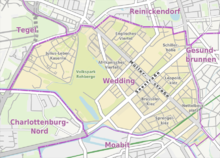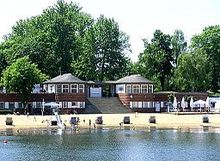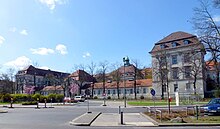Berlin-Wedding
|
Wedding district of Berlin |
|
|---|---|
| Coordinates | 52 ° 33 '1 " N , 13 ° 20' 18" E |
| height | ≈ 52 m above sea level NN |
| surface | 9.23 km² |
| Residents | 86,806 (Dec. 31, 2019) |
| Population density | 9405 inhabitants / km² |
| Incorporation | 1861 |
| Postcodes | 13347, 13349, 13351, 13353, 13357, 13359, 13407, 13409 |
| District number | 0105 |
| Administrative district | center |
The Wedding is a Berliner locality in the district of Mitte . Wedding, mentioned in a document in the 13th century, was almost uninhabited for centuries until the 18th century. After the incorporation to Berlin in 1861, the population of Wedding increased. In 1920 it gave its name to the then Wedding district , which after the partition of Berlin belonged to the French sector of West Berlin . The district of Wedding in its current form emerged in 2001 from the western part of the dissolved district.
history
Wedding is already mentioned in two documents from the 13th century: In 1251 it was about "a mill in the area of the village called Weddinge, built on the river named Pankow" and in 1289 about "the real fief and the one with the Homestead Wedding associated title of a fief ”.
In the 13th century the village of Wedding was mentioned as a desert , i.e. as an abandoned settlement. The town's mill was sold to the Benedictine convent in Spandau , and the fiefdom on the outskirts of the village became the property of the city of Berlin . In the 14th century, the area was still used by the citizens of Berlin for arable farming, after which it was completely overgrown with pines and oaks and was called "Berliner Stadtheide". In the 17th century a manor was laid out in the area of today's Nettelbeckplatz , which was handed over to the Brandenburg elector in 1603 . He had a Vorwerk built from it. The estate was thus the electoral domain and legally no longer part of the city of Berlin.
In connection with the expansion of Berlin and the wood required for it, the Stadtheide was almost completely cleared, so that the land around Wedding became deserted. In the 18th century, the extensive settlement of the area north of Berlin and thus also of Wedding began. In 1778 the first colonist houses were built in the area of today's Weddingplatz. In 1782 Frederick II founded a colony, which was named Wedding or Neu-Wedding because of the proximity of the estate.
In 1861 Wedding was incorporated into Berlin. He gave his name to the Wedding district, founded in 1920 and existing until 2000 , which encompassed the area of today's districts of Wedding and Gesundbrunnen .
After the Second World War in 1945 until German reunification in 1990, the Wedding district belonged to the French sector of Berlin.
Since the 1970s, numerous - often Turkish - guest workers and other immigrants have settled in the traditional working-class district because there was inexpensive living space there, which gave the district a multicultural character.
After the Wedding district merged into the new, larger Mitte district in 2001, Wedding and Gesundbrunnen received the status of Berlin districts.
Place name
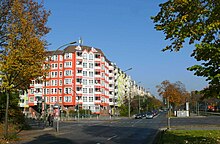
Residents and often also the Berlin media use the term “Wedding” to refer to the area of the former Wedding district.
Wedding is one of the few place names that are used with an article in German ; Wedding is reminiscent of its origins as the estate and Vorwerk built by the nobleman Rudolf de Weddinghe , and consequently one said: “He lives on Wedding.” (In the city dialect : “He lives uff'm Wedding” or “on Wedding”. ) Today, however, “in Wedding” is preferred.
“Where do I live? Like all fine Leite, Berlin W. on the back with a 'thing'! - ?? - Well man, vastehste nich, Berlin Wedding! "
Neighborhoods and neighborhoods
- African quarter , also: Otawikiez
- Antonkiez
- English quarter with the Schillerpark settlement
- Brussels neighborhood , also: Belgian quarter
- Julius-Leber-Kaserne , also: Quartier Napoléon
- Leopoldkiez , also: Osramkiez
- Sprengelkiez , also: Sparrplatz-Quartier
population
With 86,806 inhabitants (as of December 30, 2019), Wedding is the third most populous district (out of six) in the Mitte district. He has an average age of 38 to 40 years.
The proportion of the foreign population in Wedding is 30%. In the entire Mitte district, the proportion of foreigners is 29.1%, while the Berlin average is 15.3%. 48.3% of the residents in Wedding have a migration background .
Development
Wedding is largely characterized by old buildings with rear buildings from the Wilhelminian era and new housing estates from the 1920s to 1950s. While in the old district of Wedding the number of apartments in Wilhelminian style buildings, which mainly characterize the area south of Seestrasse, is slightly higher than that of apartments in residential areas, none of the other Berlin districts has a similarly high proportion of these settlements. The African Quarter between the Rehberge Park and the Schiller Park is characteristic here . The settlement buildings of the 1920s and 1930s, surrounded by typical green spaces, are decisive here. Worth mentioning are especially the the UNESCO World Heritage belonging settlement Schiller Park and the Friedrich Ebert settlement . In addition, there are multi-storey buildings for social housing from the 1970s and 1980s.
The Erika-Heß-Eisstadion is located near the Reinickendorfer Straße underground station and Wedding train station . In winter it is the home of the Berlin ice hockey club FASS Berlin . Because of the few ice rinks in Berlin, the ice rink was also the second home of ECC Preussen Berlin from 2009 to 2012 .
Important places in Wedding
Green areas in Wedding
- Schiller Park
- Rehberge public park
- Goethe Park
- Plötzensee outdoor pool
- North Harbor Park
- Sprengelpark
- In the area of the School Environment Center in the middle of Scharnweberstrasse 158/159 lies the Wedding dune . It is the last inner-city ice age dune in Germany and is protected as an extensive natural monument.
- In Wedding, large areas are used as allotment gardens.
Infrastructure and traffic
Wedding has several nationally known institutions that are among the largest employers in the city.
Industry
- Until the takeover by Bayer AG , Schering AG, Berlin's only DAX group, had its headquarters in Müllerstrasse. The company premises extend on both sides of Fennstrasse from Müllerstrasse to Nordhafen .
- The buildings of what was once the largest incandescent lamp factory in Europe, Osram Plant B, are located between Seestrasse and Groninger Strasse. After Osram stopped producing incandescent lamps here in 1988, today's Osram courtyards are used as a commercial center by small businesses from the retail, service and craft sectors as well as by scientific and research institutions.
BVG
- With the main workshop in Seestrasse , BVG operates a workshop for the maintenance of small and large-profile cars. The complex, which opened around 1923, is a listed building monument.
- The Müllerstrasse depot, which opened in 1927, is responsible for all bus traffic in the north of Berlin. According to the Berliner Verkehrsbetriebe, 239 buses are currently located in the courtyard, and 437 employees of the transport service have their place of work in the courtyard. In addition, the BVG driving school, known as the Verkehrsakademie Omnibus, and its clothing store are located on site. The facility is a listed building monument.
Health facilities
- The Rudolf Virchow Hospital located on Augustenburger Platz is one of the largest hospitals in Berlin. It was built as a municipal hospital from 1899 to 1906. During the division of Berlin, the Rudolf Virchow Hospital served as the University Hospital of the Free University of Berlin from the 1980s . The Rudolf Virchow Hospital has belonged to the Humboldt University since 1995 and has been the Charité's Virchow Clinic (CVK) campus since 1998 .
- The German Heart Center Berlin is also located on campus , where around 6,500 inpatients and 14,000 outpatients are treated annually.
- The Robert Koch Institute on the north bank is a central monitoring and research facility in the Federal Republic of Germany . It reports directly to the Federal Ministry of Health (BMG). There is also a mausoleum for Robert Koch , whose name the institute bears. The main building is also a listed building monument.
- The Kaiser- und Kaiserin-Friedrich Children's Hospital on Reinickendorfer Strasse was established in 1890 by Rudolf Virchow and Adolf Baginsky to reduce child mortality. Today the building houses the Evangelical Geriatric Center. The Kaiser- und Kaiserin-Friedrich Children's Hospital has made a significant contribution to combating child mortality. The facility is also a listed building monument.
- The Paul-Gerhardt-Stift in Müllerstraße is a private foundation founded on June 7, 1876 by the Protestant pastor Carl Schlegel for the care of the sick, children and the elderly in the Christian tradition of charity. It served as a hospital until 1987. A medical center is now housed in the courtyard buildings.
Educational institutions
schools
| School No. | School name | School branch | address |
|---|---|---|---|
| 01B04 | OSZ Health I | Vocational school | Schwyzer Strasse 6–8 |
| 01P48 | meco Academy GmbH | Technical school | Seestrasse 64 |
| 01G24 | Gottfried Röhl Elementary School | primary school | Hungary Street 75 |
| 01G28 | Brothers Grimm Primary School | primary school | Tegeler Strasse 18/19 |
| 01G31 | Wedding elementary school | primary school | Antonstrasse 10 |
| 01G40 | Möwensee primary school | primary school | African Road 123–125 |
| 01G41 | Erika Mann Elementary School | primary school | Utrecht Strasse 25-27 |
| 01G42 | Anna Lindh School (primary school) | primary school | Guineastrasse 17/18 |
| 01G45 | Leo Lionni Elementary School | primary school | Müllerstrasse 158 |
| 01P50 | Including all-day primary school in Berlin Mitte | Primary school (private) | Tegeler Strasse 13 |
| 01Y08 | Lessing high school | high school | Schöningstrasse 17 |
| 01K02 | Ernst Schering School | Integrated secondary school | Lütticher Strasse 47/48 |
| 01K08 | School at the Schillerpark | Integrated secondary school | Ofener Strasse 6 |
| 01A01 | 1. School practical seminar middle | Practical school seminar | Tegeler Strasse 16 |
| 01A02 | 2. School practical seminar middle | Practical school seminar | Tegeler Strasse 16 |
| 01A03 | 3. School practical seminar middle | Practical school seminar | Tegeler Strasse 16 |
| 01A06 | 4. School practical seminar middle | Practical school seminar | Tegeler Strasse 16 |
| 01E10 | SiliconStudioAcademy-Berlin | Other supplementary school | Groninger Strasse 25 |
| 01S05 | School in the Charité | Other funding priorities | Augustenburger Platz 1 |
Universities and other schools
- The Beuth University of Applied Sciences in Berlin has been training engineers and technicians at its headquarters in Lütticher Strasse since 1913. Today it is located on the site between Luxemburgerstrasse and Limburger Strasse and has around 11,000 students spread over several locations. The building on Lütticher Straße is a listed building monument.
- The Institute for Fermentation Trade and Biotechnology on Seestrasse has existed since 1890. It made significant contributions to scientific fermentation . In the 21st century, the test and training institute for brewing (VLB) of the German Brewers' Association is located on the site . From 1891 to 1981 the VLB Berlin operated its university brewery at Seestrasse 13 , which in the 1920s had an annual output of almost 45,000 hectoliters . The brewing operation was stopped in 1981. The building is a listed monument.
- The Academy for Cardio Technology at the German Heart Center has been training cardio technicians since 1988.
Cultural institutions
- The Center Français de Berlin in Müllerstrasse was set up around 1960 on behalf of the French military government as the Center Culturel Français as a meeting place for the promotion of French culture in Berlin. After the Allies withdrew, it was reopened as the Center Français de Berlin and serves to promote Franco-German friendship and European ideas on international understanding. The 'City Kino Wedding' is located in the center. The building is a listed monument.
- The Anti-War Museum has been located in Brussels Street 21 since 1984 and documents the horrors of past world wars , pacifist actions and the current war situation in the world.
- Since 2000, the Franco-German folk festival has been taking place on the central fairground at Kurt-Schumacher-Damm as the largest festival in Berlin. Previously, it had been held since 1963 on the opposite site in Berlin-Tegel , which is now used as a car park.
- The Atze Music Theater in Max Beckmann Hall on the Luxembourg road has the largest musical theater for children of primary school age about 90,000 spectators per year.
- The Prime Time Theater is a modern folk theater that resides next to the Kurt-Schumacher-Haus on the corner of Müllerstrasse and Burgsdorfstrasse .
- The cinema Cineplex Alhambra is next to the cinema in the Center Français de Berlin the last remaining cinema in the district. It originated here in 1921 as 'Apollo', was destroyed in 1943 and rebuilt in 1953. In 1999 the old house was torn down and replaced by a new building. In 2004 the "Alhambra" came under forced administration, the house was leased to the operating company Kinocenter Neukölln GmbH (KNC).
Others
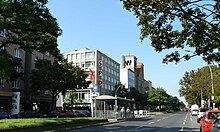
- The Kurt-Schumacher-Haus in Müllerstrasse was built around 1962 as the seat of the Berlin SPD regional association , which is still based here today. The building is a listed monument.
- The Julius-Leber-Kaserne is the largest barracks in Berlin. From August 1945 to 1994 it was the "Quartier Napoléon", the headquarters of the Forces Françaises à Berlin .
- The Kombibad Seestrasse is located on Ungarnstrasse.
Local public transport

The following public transport routes exist in the Wedding district :
Train
- Ring railway lines S41 and S42 with the Wedding station between Müllerstraße and Nettelbeckplatz .
Subway
tram
- Line M13 Virchow-Klinikum - U Warschauer Straße
- Line 50 Virchow-Klinikum - Guyotstraße ( French: Buchholz )
bus
- Line M27 S + U Jungfernheide - S + U Pankow
- Line 106 U Seestraße - Lindenhof ( Schöneberg )
- Line 120 S + U Hauptbahnhof - S + U Wittenau
- Line 142 U Leopoldplatz - S Ostbahnhof
- Line 221 U Leopoldplatz - Bernshausener Ring ( Märkisches Viertel )
- Line 247 U Leopoldplatz - S Nordbahnhof
- Line 327 U Leopoldplatz - S Schönholz
Private transport
Several cycle routes lead through Wedding, for example the long-distance cycle route Berlin – Copenhagen .
One of the OsramHöfe , Groninger Strasse
JobCenter Mitte Müllerstraße (formerly the employment office) at Müllerstraße 16
Schillerpark housing estate, listed houses on Bristolstrasse
Center Français on Müllerstrasse
Miniature Eiffel Tower at the Center Français
Edinburger Strasse, at the Schillerpark
Müllerstraße near
Rehberge underground stationFormer Crematorium at the urn cemetery on Richtstrasse
Fountain dance on the volcano at Nettelbeckplatz by Ludmila Seefried-Matějková , 1988
See also
- List of streets and squares in Berlin-Wedding
- List of cinemas in Berlin-Wedding
- List of cultural monuments in Berlin-Wedding
- List of stumbling blocks in Berlin-Wedding
- List of street fountains in Berlin's Mitte district : sorting of districts
literature
- Horst Evers : Wedding. 37 stories about the pearl among Berlin's districts. 3. Edition. Fahner Verlag, Lauf 1997, ISBN 3-924158-33-9 .
- Franz Gottwald (Hrsg.): Heimatbuch vom Wedding . Kribe-Verlag, Berlin 1924.
- Gerhild HM Komander : The Wedding - On the way from red to colored. Berlin Story Verlag, Berlin 2006, ISBN 3-929829-38-X .
- Ute Langeheinecke: Wedding as a rural settlement 1720 to 1840. Gebr. Mann Verlag, Berlin 1992, ISBN 3-7861-1658-X .
- Ralf Schmiedecke: Wedding - in the middle of Berlin. Sutton, Erfurt 2001, ISBN 978-3-89702-366-6 (The archive images series).
- Ralf Schmiedecke: Berlin-Wedding - New pictures from old times. Sutton, Erfurt 2005, ISBN 3-89702-866-2 (series archive images ).
- Christian Simon: 750 Years of Wedding - A Chronicle. Berlin 2001, ISBN 3-8311-1777-2 .
- Heiko Werning : In wild Wedding. Between the ghetto and gentrification . Edition Tiamat, Berlin 2014, ISBN 978-3-89320-185-3 .
Movies
- No murder, no manslaughter , directed by Uwe Schrader , 1985
- Wedding , directed by Heiko Schier , 1990
- Kroko , directed by Sylke Enders , 2003
- Tempel , TV series on ZDFneo , 2016
Web links
- District: Wedding on the website of the district office center
- The Wedding district on the website of the district management team Sparrplatz
- Info page of the Friends of Brussels Kiez e. V. in Wedding
- Where was the village of Wedding?
- Address directory for the living-world-oriented rooms in Berlin-Mitte; pdf
- Picture book: Berlin-Wedding , report by RBB (Memento of the original)
- Anne Haeming: Now also Wedding? In: The daily newspaper . August 3, 2019 (A literary tour of the neighborhood.).
Individual evidence
- ^ G. Suchsdorf: History of the healthy well. Reprinted separately from the newspaper Die Quelle. Berlin 1891.
- ^ Story of Wedding ( Memento from May 17, 2013 in the Internet Archive )
- ↑ Hans Ostwald: Der Urberliner; Paul Francke Verlag, Berlin 1920.
- ↑ Residents registered under registration law in the State of Berlin on December 31, 2013 (PDF; 2.7 MB)
- ↑ Berlin Environmental Atlas: Berlin Environmental Atlas 06.07 Urban Structure / 06.08 Urban Structure - differentiated (Edition 2008), berlin.de, accessed on February 28, 2016
- ↑ Ice Age in Wedding - Germany's last inner-city Ice Age dune visible again. berlin.de, February 16, 2012, accessed January 25, 2013 .
- ↑ LDL Berlin: Siegmund Bergmann Glühlampen AG & Osram GmbH (from 1935)
- ↑ LDL Berlin: main subway workshop of Nord-Südbahn AG
- ↑ LDL Berlin: BVG bus depot with residential complex
- ↑ LDL Berlin: Rudolf Virchow Hospital
- ↑ LDL Berlin: Royal Prussian Institute for Infectious Diseases & Mausoleum for Robert Koch & Robert Koch Institute
- ↑ LDL Berlin: Rudolf Virchow Children's Hospital & Geriatric Home
- ↑ LDL Berlin: Paul-Gerhardt-Stift
- ↑ LDL Berlin: Beuth School
- ↑ LDL Berlin: Institute for Fermentation Industry and Biotechnology
- ↑ LDL Berlin: Center Culturel Français
- ↑ LDL Berlin: State Engineering School Gauß
- ↑ Kino-Wiki Wedding Alhambra (Apollo) accessed on December 12, 2014
- ↑ LDL Berlin: Kurt Schumacher House & SPD Building
- ↑ Berliner Bäderbetriebe Kombibad Seestrasse
- ↑ Bike-Berlin-Copenhagen | Berlin – Copenhagen. Retrieved May 14, 2017 .
